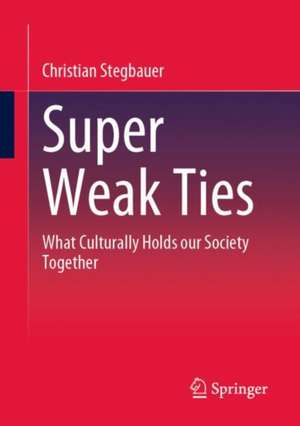Super Weak Ties: What Culturally Holds our Society Together
Autor Christian Stegbaueren Limba Engleză Paperback – 14 feb 2024
The analysis of relationships is actually the domain of network research, which has traditionally focused on strong and weak ties. However, this book explores super weak ties, which are often not consciously perceived, as their significance unfolds behind the backs of us all. Although one can hardly speak of relationships in the traditional sense, these super weak ties are often just as influential as stronger ones.The orienting effect is particularly pronounced when there are similarities in interests and situations between observers and those being observed. Without transmissions facilitated by super weak ties, it would be challenging to arrive at cultural commonalities in society.
Preț: 181.27 lei
Nou
Puncte Express: 272
Preț estimativ în valută:
34.69€ • 36.34$ • 28.75£
34.69€ • 36.34$ • 28.75£
Carte disponibilă
Livrare economică 19 martie-02 aprilie
Preluare comenzi: 021 569.72.76
Specificații
ISBN-13: 9783658438876
ISBN-10: 3658438878
Pagini: 166
Ilustrații: XIII, 166 p. 8 illus., 7 illus. in color.
Dimensiuni: 148 x 210 mm
Greutate: 0.3 kg
Ediția:1st ed. 2024
Editura: Springer Fachmedien Wiesbaden
Colecția Springer
Locul publicării:Wiesbaden, Germany
ISBN-10: 3658438878
Pagini: 166
Ilustrații: XIII, 166 p. 8 illus., 7 illus. in color.
Dimensiuni: 148 x 210 mm
Greutate: 0.3 kg
Ediția:1st ed. 2024
Editura: Springer Fachmedien Wiesbaden
Colecția Springer
Locul publicării:Wiesbaden, Germany
Cuprins
Why super weak ties?.- The human being in the web of ties.- Components of the effect of super weak ties- Super weak ties: The traffic light and the opera.- The leaning tower of Pisa.- How super weak ties affect fashion.- Conclusion: What makes super weak ties so important.
Notă biografică
Prof. Dr. Christian Stegbauer teaches sociology and network research at Goethe University Frankfurt.
Textul de pe ultima copertă
In this book, it is explained how we learn from each other and how people adapt their behavior to one another. We orient ourselves to others by observing how they behave in specific situations.
The analysis of relationships is actually the domain of network research, which has traditionally focused on strong and weak ties. However, this book explores super weak ties, which are often not consciously perceived, as their significance unfolds behind the backs of us all. Although one can hardly speak of relationships in the traditional sense, these super weak ties are often just as influential as stronger ones.The orienting effect is particularly pronounced when there are similarities in interests and situations between observers and those being observed. Without transmissions facilitated by super weak ties, it would be challenging to arrive at cultural commonalities in society.The author
Prof. Dr. Christian Stegbauer teaches sociology andnetwork research at Goethe University Frankfurt.
The translation was done with the help of artificial intelligence. A subsequent human revision was done primarily in terms of content.
The analysis of relationships is actually the domain of network research, which has traditionally focused on strong and weak ties. However, this book explores super weak ties, which are often not consciously perceived, as their significance unfolds behind the backs of us all. Although one can hardly speak of relationships in the traditional sense, these super weak ties are often just as influential as stronger ones.The orienting effect is particularly pronounced when there are similarities in interests and situations between observers and those being observed. Without transmissions facilitated by super weak ties, it would be challenging to arrive at cultural commonalities in society.The author
Prof. Dr. Christian Stegbauer teaches sociology andnetwork research at Goethe University Frankfurt.
The translation was done with the help of artificial intelligence. A subsequent human revision was done primarily in terms of content.
Caracteristici
Can one recognize people's affiliation to professions and academic fields based on their clothing? Yes, and this book explains why! A contribution to the emergence of culture.
